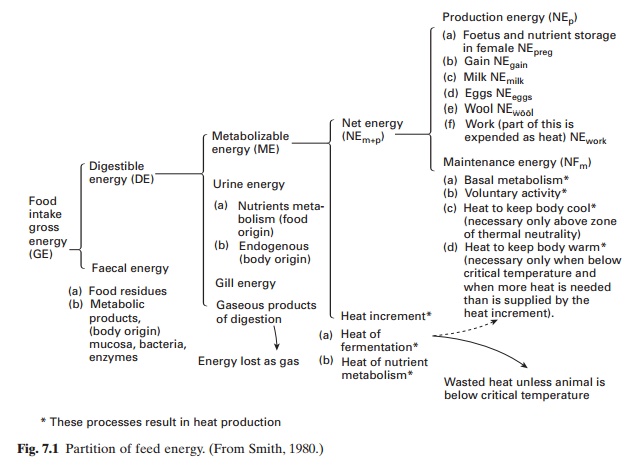Chapter: Aquaculture Principles and Practices: Nutrition and Feeds
Energy metabolism- Nutrition and Feeds of Fish
Energy metabolism
From among the two types of energy, heat energy utilized for maintaining
body temperature and the free energy available for biological activity and
growth, the latter is more important for poikilothermal animals like fish. Free
energy is needed for maintenance, growth and reproduction. Seaweeds and other
plants can obtain it directly from the sun and water and synthesize the complex
molecules that constitute its structural parts. Animal species have to depend
on the oxidation of the complex molecules contained in the food that they eat
for energy requirements. The complex molecules are broken down during digestive
processes to simpler molecules and are absorbed into the body, where oxidation
occurs and energy is released. The biological process of energy utilization is
known as metabolism and the rate at which it is utilized is referred to as the
metabolic rate.
Energy metabolism in cold-blooded animals such as fish is different from
that in mammals and birds in that they do not expend energy to maintain a body
temperature different from their environment as warm-blooded animals do, and
the excretion of waste nitrogen requires less energy than in homeothermic land
animals.
Fish are the most efficient converters of energy and protein among all
farmed animals. While the energy and protein conversion efficiencies in farmed
warm-blooded animals (sheep, cattle, pigs, chicken) are in the ranges of 1.7–17
per cent and 3–12 per cent respectively, the corresponding ranges for salmonids
are much higher at 30–40 per cent and 20–25 per cent respectively (Rerat and
Kaushik, 1995; De Silva, 1999).

The metabolic rate in fish, which is probably the most studied
aquaculture animal group, is influenced by temperature, age or size, activity
and seasonal and diurnal fluctuations of body function. It is also affected by
oxygen or carbon dioxide concentration, pH and salinity of the water.The energy
requirements necessary for all metabolic functions can be calculated for each
species. For example, carp utilize 25 cal/dec2/h at 25°C. Approximately 70 per cent
of this is used for maintenance and growth and the remaining 30 per cent is
lost to the environment. As the body temperature of the fish is maintained at
or near the environmental water temperature, the heat that is produced is lost
to the environment. The biological partition of energy is shown in fig. 7.1.
Energy is also lost in faeces, urine and gill excretions, besides the small
amounts of heat lost from external body surface.
Related Topics